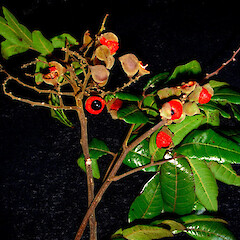Alectryon excelsus subsp. excelsus
Common name
New Zealand ash, tītoki
Synonyms
Alectryon excelsus Gaert., Alectryon excelsus Gaertn. var. excelsus
Family
Sapindaceae
Flora category
Vascular – Native
Endemic taxon
Yes
Endemic genus
No
Endemic family
No
Structural class
Trees & Shrubs - Dicotyledons
NVS code
The National Vegetation Survey (NVS) Databank is a physical archive and electronic databank containing records of over 94,000 vegetation survey plots - including data from over 19,000 permanent plots. NVS maintains a standard set of species code abbreviations that correspond to standard scientific plant names from the Ngä Tipu o Aotearoa - New Zealand Plants database.
ALEEXC
Chromosome number
2n = 32
Current conservation status
The conservation status of all known New Zealand vascular plant taxa at the rank of species and below were reassessed in 2017 using the New Zealand Threat Classification System (NZTCS) – more information about this can be found on the NZTCS website. This report includes a statistical summary and brief notes on changes since 2012 and replaces all previous NZTCS lists for vascular plants.
Please note, threat classifications are often suggested by authors when publications fall between NZTCS assessment periods – an interim threat classification status has not been assessed by the NZTCS panel.
- Conservation status of New Zealand indigenous vascular plants, 2017 . 2018. Peter J. de Lange, Jeremy R. Rolfe, John W. Barkla, Shannel P. Courtney, Paul D. Champion, Leon R. Perrie, Sarah M. Beadel, Kerry A. Ford, Ilse Breitwieser, Ines Schönberger, Rowan Hindmarsh-Walls, Peter B. Heenan and Kate Ladley. Department of Conservation. Source: NZTCS and licensed by DOC for reuse under the Creative Commons Attribution 4.0 International licence.
2017 | Not Threatened
Previous conservation statuses
2012 | Not Threatened
2009 | Not Threatened
2004 | Not Threatened
Brief description
Small tree with spreading branches and a dark fluted trunk. Leaves with 3-7 offset pairs of glossy dark green leaflets. Flowers red, in small, clustered, sprays. Fruit fleshy red partly surrounding a black seed and expanding from a furry brown capsule.
Distribution
Endemic. North and South Islands from Te Paki to Banks Peninsula
Habitat
A widespread coastal to lowland forest tree. Often favouring well drained, fertile, alluvial soils along river banks and associated terraces. It is also a major component of coastal forests, particularly those developed within exposed situations or on basaltic or andesite volcanics. It is a common offshore island tree within the Hauraki Gulf. The large fruits are bird dispersed and so titoki trees often occur as a sparse components of most lowland forest types, throughout the North Island.
Detailed description
Tree between 10m and 20m tall. Branches stout, erect, all parts invested with fine, velutinous, ferrugineous hairs. Bark brown. Adult leaves dark green, matt when mature, imparipinnate, alternate 80-260 mm long. Leaflets 3-7 pairs; lamina 45-105 x 19-40 mm, subcoriaceous, lanceolate, oblong or narrowly-ovate, apex, subacute often acuminate, rarely obtuse; base cuneate, truncate to oblique, upper leaf surface matt; lamina margin entire or deeply serrated 1-4 times near apex. Inflorescences axillary 90-120 mm long, sparingly branched panicles. Flowers bisexual or staminate. Petals absent. Stamens 5-8 in bisexual and 6-10 in staminate flowers, crimson. Stigma ovoid, in staminate flowers ovary tholiform, style absent, in perfect flowers broadly urceolate, style 1.5-2 mm, erect. Fruits sessile, 1-2-lobed, 14-20 x 9-14 mm, pubescent, globular, carina 3-5 mm long on one side. Seed 7-10 x 4-8 mm, subglobose, black, lustrous, sarcotesta fleshy, scarlet, papillose.
Similar taxa
Alectryon excelsus subsp. grandis (Cheeseman) de Lange et E.K.Cameron which is a smaller shrub or tree, usually with a multi-trunked habit. The leaves of subsp. grandis are very glossy (vernicose), distinctly bullate, with 2-4 pairs of broadly oblong or ovate leaflets. A. excelsus subsp. grandis is an allopatric Three Kings Islands endemic.
Flowering
October - December (-June)
Flower colours
Red/Pink
Fruiting
November - August
Life cycle
Arillate seeds are dispersed by frugivory (Thorsen et al., 2009).
Propagation technique
Easy from fresh seed. Grows quickly in suitable conditions, preferring well drained, fertile soils in full sun or partial shade. A popular street tree, and as the fruit is bird dispersed it often naturalises in gardens from street side plantings
Etymology
alectryon: In Greek mythology Alectryon was punished and turned into a rooster by Ares after failing to keep watch, possible refers to a cockscomb
excelsus: Tall
Taxonomic notes
The exact status of Alectryon plants on the Poor Knights Islands needs further investigation. In some respects these plants appear intermediate between A. excelsus subsp. excelsus and subsp. grandis (de Lange et al. 1999).
Poisonous plant
The round black seeds are best avoided despite limited information on their toxicity. many plants in the same family are poisonous. Click on this link for more information about Poisonous native plants.
Attribution
Fact Sheet prepared by P.J. de Lange (1 August 2005). Description by P.J. de Lange based in part on de Lange et al. (1999).
References and further reading
Cameron, E.K. 1998. Frost resistance in titoki Alectryon. Auckland Botanical Society Journal 53: 15.
de Lange, P.J.; Cameron, E.K.; Murray, B.G. 1999: Alectryon excelsus subsp. grandis (Sapindaceae): a new combination for an uncommon small tree endemic to the Three Kings Islands, New Zealand. New Zealand Journal of Botany 37: 7-16.
Duguid, F. 1961. Flowering in titoki. Wellington Botanical Society Bulletin 32: 16
Thorsen, M. J.; Dickinson, K. J. M.; Seddon, P. J. 2009. Seed dispersal systems in the New Zealand flora. Perspectives in Plant Ecology, Evolution and Systematics 11: 285-309
NZPCN Fact Sheet citation
Please cite as: de Lange, P.J. (Year at time of access): Alectryon excelsus subsp. excelsus Fact Sheet (content continuously updated). New Zealand Plant Conservation Network. https://www.nzpcn.org.nz/flora/species/alectryon-excelsus-subsp-excelsus/ (Date website was queried)


















